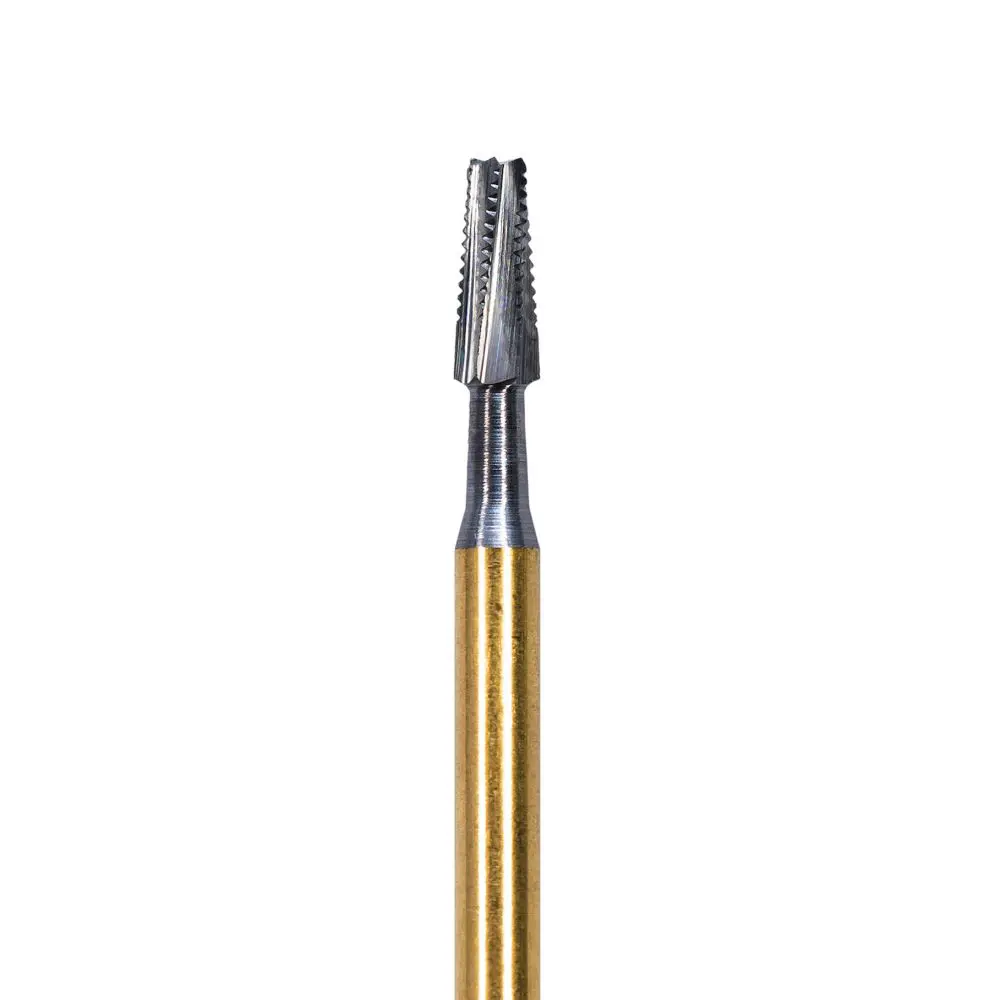Introduction to Surgical Burrs
● Definition and Basic Function
Surgical burrs are precision instruments critical to various surgical specialties, including dentistry, orthopedics, and neurosurgery. Designed to remove hard tissues such as bone or teeth, they are indispensable tools that enable surgeons to perform procedures with high precision and minimal trauma to surrounding tissue. Whether used in reshaping a bone, cutting through enamel, or removing a tumor, the surgical burr's ability to precisely define and execute cutting edges is essential for successful surgical outcomes.
● Types of Surgical Burrs
Surgical burrs come in various shapes and sizes, each carefully engineered for specific applications. The spectrum includes cylindrical burrs, flame-shaped burrs, round burrs, and specialty burrs, such as the 702 surgical bur. Each design offers unique advantages based on the surgical task at hand—whether for rapid tissue removal or fine, delicate work. These burrs may be made from various materials, including stainless steel and diamond, to enhance their durability and cutting efficiency.
History of Surgical Burrs
● Evolution of Design and Technology
The evolution of surgical burrs parallels advancements in medical technology and understanding of human anatomy. Initially primitive, these tools have undergone substantial transformation. Modern burrs are the result of intricate design processes and engineering marvels, with CNC precision grinding technology playing a pivotal role. The adoption of high-quality materials, coupled with advanced fabrication techniques, has led to the creation of surgical burrs that are both effective and reliable.
● Key Milestones in Surgical Burr Development
Key milestones in the development of surgical burrs include the transition from handmade to machine-manufactured instruments, the introduction of carbide burrs for enhanced durability, and the integration of diamond coatings for superior cutting efficiency. These innovations have expanded the scope and capability of surgical procedures, enhancing patient outcomes and surgical precision.
Materials Used for Surgical Burrs
● Common Materials: Stainless Steel and Diamond
Surgical burrs are commonly crafted from robust materials like stainless steel, which offer strength and durability, and diamond, which provides unmatched sharpness and cutting ability. Steel burrs are ideal for applications requiring rotational strength and resilience, while diamond burrs are favored in procedures necessitating extreme precision due to their superior edge retention.
● Advantages of Each Material Type
Each material brings distinct advantages to the table: stainless steel burrs are cost-effective and capable of handling heavy-duty tasks, whereas diamond burrs excel in tasks requiring fine accuracy, such as in delicate dental procedures. The choice of material is often dictated by the specific demands of the surgical procedure and desired outcomes.
Applications in Dentistry
● Role in Crown Lengthening
In dentistry, surgical burrs are crucial for procedures such as crown lengthening, where they help contour the gum line and reshape the underlying bone. The precision offered by surgical burrs ensures minimal damage to adjacent tissues, promoting faster healing and optimal esthetic results.
● Importance in Bone Reduction
Surgical burrs are also employed in bone reduction surgeries to remove small segments of bone, providing the necessary space for prosthetics or correcting anatomical anomalies. Their use translates to less invasive procedures and better patient outcomes due to reduced operation times and enhanced precision.
Usage in Orthopedic Surgeries
● Applications in Bone Shaping and Removal
Orthopedic surgeries frequently utilize surgical burrs for bone shaping and removal. These tools allow surgeons to effectively modify bone structure, whether for joint replacement, fracture repair, or deformity correction. The precision of burrs is paramount, as it helps in reducing the risk of collateral damage and speeds up recovery times.
● Burrs in Joint Replacement Procedures
In joint replacement surgeries, burrs play a critical role in preparing bone surfaces to ensure proper fit and integration of prosthetic components. Their ability to precisely carve and shape bone is essential for the longevity and success of these interventions.
Innovations in Surgical Burr Technology
● Recent Advancements and Innovations
Technological advancements have greatly influenced the development of surgical burrs. Innovations such as enhanced 5-axis CNC precision grinding technology have led to burrs offering greater accuracy and efficiency. Moreover, recent developments have focused on ergonomic designs which reduce surgeon fatigue and improve operation times.
● Impact of Technology on Surgical Outcomes
These technological improvements have not only increased the efficacy of surgical burrs but have also augmented the overall quality of surgical practices. As a result, surgical procedures are now safer, faster, and more accessible, significantly improving patient care standards.
Safety and Precision in Surgery
● Importance of Accuracy in Surgical Procedures
Precision in surgical procedures is non-negotiable, as even minor inaccuracies can lead to significant complications. Surgical burrs contribute significantly to maintaining this accuracy, ensuring procedures are performed with the highest degree of precision, which is crucial for patient safety and successful surgical outcomes.
● Safety Features in Modern Surgical Burrs
Modern surgical burrs include safety features such as sharpness indicators and ergonomic designs that reduce the risk of slipping and ensure safe operation. The incorporation of these features reflects the ongoing commitment within the medical device industry to enhance patient and practitioner safety.
Sterilization and Maintenance
● Cleaning and Sterilization Processes
To ensure surgical burrs remain functional and safe, proper sterilization and maintenance are essential. Techniques such as autoclaving and chemical sterilization effectively eliminate pathogens, preventing infection and ensuring the longevity of the tools.
● Tips for Maintaining Surgical Burrs
Routine maintenance, including inspection for wear and regular sharpening, extends the life of surgical burrs and preserves their efficiency. Adhering to manufacturer guidelines regarding cleaning and storage can prevent damage and ensure optimal performance.
Challenges and Limitations
● Common Challenges Faced During Use
Despite their efficacy, the use of surgical burrs presents certain challenges. Issues such as tool wear and heat generation during use can affect performance and require careful management to prevent complications.
● How Technology is Addressing These Limitations
Continued research and technological innovation are addressing these challenges. Developments like heat-resistant coatings and improved material formulations are helping mitigate wear and temperature concerns, enhancing the overall reliability of surgical burrs.
Future Prospects of Surgical Burrs
● Emerging Trends and Future Innovations
The future of surgical burrs is promising, with trends pointing toward increased automation and integration of AI to further enhance precision and efficiency. The development of smart burrs, which can adjust their functionality in real-time during surgery, is on the horizon.
● Potential Impact on Surgical Practices
These advancements will likely revolutionize surgical practices, making surgeries less invasive, more precise, and possibly reducing recovery times significantly. As surgical burrs continue to evolve, they will empower surgeons to push the boundaries of what is possible in medicine today.
Conclusion
Surgical burrs, such as the 702 surgical bur, are indispensable tools in modern medicine, playing a critical role in enhancing the precision and efficacy of surgical procedures across various specialties. The innovations and advancements in surgical burr technology, coupled with ongoing efforts in maintenance and safety, continue to push the boundaries of medical science, offering surgeons and patients alike new possibilities in surgical care.
About Boyue
Jiaxing Boyue Medical Equipment Co., Ltd is a leading manufacturer specializing in 5-axis CNC precision grinding technology, producing an extensive range of medical rotary cutting tools. Boyue's offerings include dental burs, files, bone drills, and more, serving orthopedic and neurosurgical needs. With over 23 years of experience, Boyue stands out for its commitment to quality and innovation, providing tailored solutions that meet diverse customer requirements while maintaining competitive pricing and service excellence.

Post time: 2024-10-16 10:28:04


